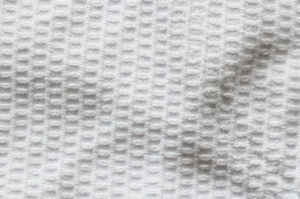The Ultimate Gi Buyers Guide
Have you Ever gone online to shop for gis and had a really hard time figuring out which gis to consider? In a constantly evolving market, new gis and gi companies are emerging every single day. There are many different possible weaves, weights, cuts, design points, and of course brands: picking a gi can be a bit of a hassle.
Along with my responsibilities writing for Jiu-Jitsu Magazine and various blogs and publications, I am fortunate enough to write for gireviews.net. As part of my position with Gi Reviews, I receive gis from both well established and brand new companies; I receive prototypes of new weaves as well as the run of the mill common weaves that are a dime a dozen out of Pakistan. Based on the knowledge I have accrued testing dozens of gis, I will do my best to provide you with a guide to the weaves and features that exist in this seemingly endless market.
Fabrics
The first thing most brands will advertise when showing off a product is the weave. There are two major aspects of the weave to consider: its weight and the 
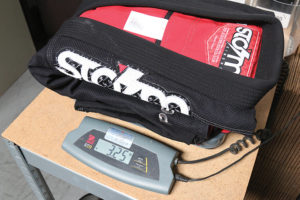 style of the weave. The weight is defined in terms of GSM, which means grams per square meter. In layman’s terms, this means that if you take a swath of gi material that is precisely one square meter, ball it up and put it on a scale, the number should be whatever the GSM is indicated as being- a 550 GSM fabricwill be 550 grams per square meter, etc. On the other hand, the actual style of weave determines how the weave looks and feels.
style of the weave. The weight is defined in terms of GSM, which means grams per square meter. In layman’s terms, this means that if you take a swath of gi material that is precisely one square meter, ball it up and put it on a scale, the number should be whatever the GSM is indicated as being- a 550 GSM fabricwill be 550 grams per square meter, etc. On the other hand, the actual style of weave determines how the weave looks and feels.
A factor to also bear in mind is that the weave and the actual material from which the gi is made are two different things. You can have two 350 GSM gold weave or pearl weave or any other weave gis made of two completely different swaths of fabric- one may be a polyblend and the other 100% cotton. Lots of companies tout the value and quality of hemp and bamboo fabrics namely because of their breathability, sustainability, and supposed antimicrobial nature.
Pearl Weave
Pearl weave is extremely common; most major gi brands have pearl weave gis as their main product line. Pakistani factories churn out pearl weave gis by the truckload. Chances are if you own a pearl weave gi, it was made in the same factory as the most expensive pearl weave gi on the market, regardless of which gi you own. Pearl weave is extremely easy to come by, and it’s relatively strong and durable for its weight.
Gold Weave
Gold weave has a smoother texture to it and tends to be a bit softer and shrinks more readily than pearl weave. Gold weave also tends to feel thicker regardless of its weight. I’ve noticed that a 550 GSM gold weave gi feels heavier than a 550 GSM pearl weave gi. Also, I’ve noticed that gold weave tends to stretch a bit more when soaked with sweat.
Honeycomb Weave
As of late, a common fabric that has emerged is honeycomb weave. It has the softness of gold weave with a bit more rigidity. I am personally most partial to honeycomb weave, but that’s just a personal preference. Honeycomb tends to feel lighter weight than many other fabrics in spite of it not necessarily being lighter. Shown is Origin’s Dragon Weave.
Ripstop
Because people like to travel and train far from home, some companies have begun to produce ripstop gis for the purpose of giving people a lighter weight product that takes up less space in a suitcase. Ripstop gis are made out of a thin but tough material. The main disadvantages of ripstop is that it is not IBJJF legal (unlike the above weaves) and it tends to not absorb sweat, making it feel a bit awkward if you’re used to more absorbent materials.
There are countless materials types and variations, but a factor that is far more objective and tangible is weight. Generally speaking, heavier gis feel coarser to the touch and are more difficult to grip while lighter gis give the wearer lighter sensation, which means that the gi may be untucked easier, but it also means that at competitions that require weigh in with the gi, you can weigh a bit more because your gi weighs less.
There are also several companies that have proprietary weaves. For example, the “Hyperfly Weave” or Origin’s “Axiom”, “Dragon”, and “Gorilla” weaves. Many other companies out there have used this as a marketing tactic, and there is definitely some merit to it; these weaves seem to garner fan followings of their own.
Features
As part of the art of selling gis, companies often include special features to accompany their bombastic weave names and unusual weights. In all  seriousness, some of these features can actually be really helpful to the wearer and should be considered as selling points for any given product.
seriousness, some of these features can actually be really helpful to the wearer and should be considered as selling points for any given product.
Perhaps my favorite thing a gi company can do is hide material inside the gi. This can mean that there is ripstop, or some other material, extending past the collar and cuffs, or that there is hidden gi material in the knees or crotch area. Hidden material will make a gi feel very awkward to an opponent, they grab an area expecting a given thickness or feel but the material is slipperier than expected.  Similarly gi material in a crotch gusset will make submissions from guard more effective by creating added friction when it comes in contact with the gi material on an opponent’s sleeve (reducing their ability to yank their arm out.)
Similarly gi material in a crotch gusset will make submissions from guard more effective by creating added friction when it comes in contact with the gi material on an opponent’s sleeve (reducing their ability to yank their arm out.)
The possible features that gis may have are endless, from hidden pockets to rash guard lining with sublimated print. When researching a gi, find out what each individual feature means. If all else fails, reach out to customer service from that company.
If all else fails, reach out to customer service from that company.
One word of caution: sometimes the feature winds up being a hindrance. I’ve reviewed gis with extra seam tape by the lapel that made the gi itchy and made it dig into my neck. Make sure that whatever features exist are not a detriment to the product.
Competition Legality
When selecting a gi, you need to consider where you’re going to wear it. There are so many options nowadays insofar as fashion choices for gis, it can get a bit confusing.
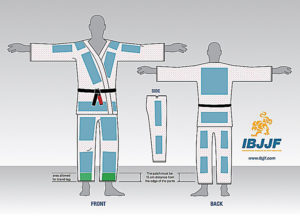 For starters: there are so many cool colors out there! Sometimes cool colors are combined: I recently saw a custom yellow gi with a green collar. There are gis that are just about every color of the rainbow. Some academies have limitations of gi colors, so you may not even be able to wear these colors to train. Then there’s competition legality: in IBJJF competition there are three legal colors: white, black and blue. I’ve seen people wear navy blue to IBJJF competitions, but the rule book is unclear so it depends on the gi checker.
For starters: there are so many cool colors out there! Sometimes cool colors are combined: I recently saw a custom yellow gi with a green collar. There are gis that are just about every color of the rainbow. Some academies have limitations of gi colors, so you may not even be able to wear these colors to train. Then there’s competition legality: in IBJJF competition there are three legal colors: white, black and blue. I’ve seen people wear navy blue to IBJJF competitions, but the rule book is unclear so it depends on the gi checker.
Speaking of gi checkers and fashion, remember that there are very specific guidelines of where patches can and cannot be placed.
Fit
Far more important than fabric or features is the fit of a gi. The nicest gi in the world that is two sizes too small will not be nice for you. Shopping for a fit isn’t always as simple as it may sound. Some companies have more sizes than others, and in many cases, those sizes mean different things between different companies. I, for example, have gis that fit me comfortably between size A1 and A4, the A1 being a particularly generous cut and the A4 being substantially undersized.
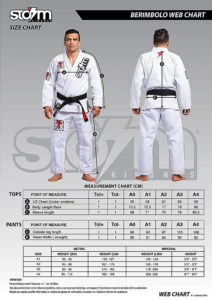 Size charts are your friend. Always consult the size chart of a gi you’re considering and if all else fails, reach out to the company. If you are purchasing a competition gi, you may want to go one half size down if half sizes are available. For example: if you normally wear A3, get A2L or even A2 instead. Gi companies that have more sizes available are more likely to have a gi that fits you particularly well.
Size charts are your friend. Always consult the size chart of a gi you’re considering and if all else fails, reach out to the company. If you are purchasing a competition gi, you may want to go one half size down if half sizes are available. For example: if you normally wear A3, get A2L or even A2 instead. Gi companies that have more sizes available are more likely to have a gi that fits you particularly well.
If a gi doesn’t fit you well, one option may be to wet areas that don’t fit and put the gi into a dryer. This method will target shrinkage to those areas that don’t fit well. If a gi fits you perfectly, wash it on cold and always let it hang dry. Remember that if you expose a gi to heat, there’s a good chance it will shrink.
For information about ideal gi fit, check out some of the major tournaments’ guidelines. Generally, you want the gis in which you train in to be similar to the gis in which you compete so you can get used to the feel of those gis.
Also, important to consider is comfort versus tactical superiority. A baggy, soft gi may be your preference in the gym, but competitors should always consider finding the tightest fit that is legal for them to wear to competition as it means the stripping of grips will be inherently easier.
Similarly, when considering gi materials, remember that at many tournaments, you have to weigh in with the gi. While your preference during training may be a heavier gi, you may be better served in competition to shed a couple of pounds of gi rather than a couple of pounds of water.
Fashion
I’ve seen a ton of memes on Facebook about white belts buying expensive limited edition gis. There are tons of brands out now, but some specific brands make exclusive, highly limited products that sell out rather quickly. Perhaps the most popular “designer” brands right now are Shoyoroll, CTRL Industries, Lucky Gi and Origin. By “designer” I mean that these brands’ products sell out fairly quickly, are priced higher than average and are sought after on the aftermarket.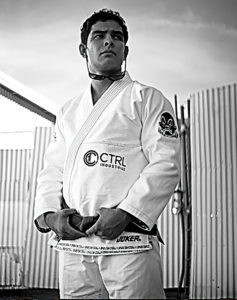
Each of these brands have built tremendous followings. When Shoyoroll or CTRL Industries drops a new gi on their website, generally it’s sold out in all sizes within 10 minutes of that release. Lucky’s actual stocks are uncertain because the owner uses a very smart marketing tactic of releasing small quantities, selling out of them and then “finding” more, but again he has no problem moving product. Origin makes their product in the US in small batches and are trying to establish their product as a peerless one by the merits of its unusual fabrics and cuts.
Once these products sell out, especially Shoyoroll and CTRL Industries, the aftermarket is an industry in and of itself. The majority of Shoyoroll gis sell for about $200, but on the aftermarket, in some cases, can fetch prices upwards of $1,000. These are the Jordans of jiu- jitsu, collectors items that may wind up being kept in their bag out of circulation.
If you are just getting started with jiu-jitsu, you may want to consider starting out with a lower end, less expensive product. Wearing a high end gi will likely not improve your jiu-jitsu.
Choosing a gi…
As you shop around, you’ll begin to understand more and more about gis. Each company has its benefits and drawbacks, and each product has something different to offer you, as a consumer.
If you’re new to jiu-jitsu don’t think that you have to spend a lot on a gi. Spend what you’re comfortable with and look for something that you’ll be comfortable in, both in feel and asthetics.
Also, always remember to research a gi you’re interested in buying by reading its reviews. Most gi reviewers do what they do as a labor of love, giving an honest assessment of the products submitted to them for review. Take the reviews as a consensus of what you can expect when you try on your new gi!


